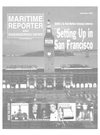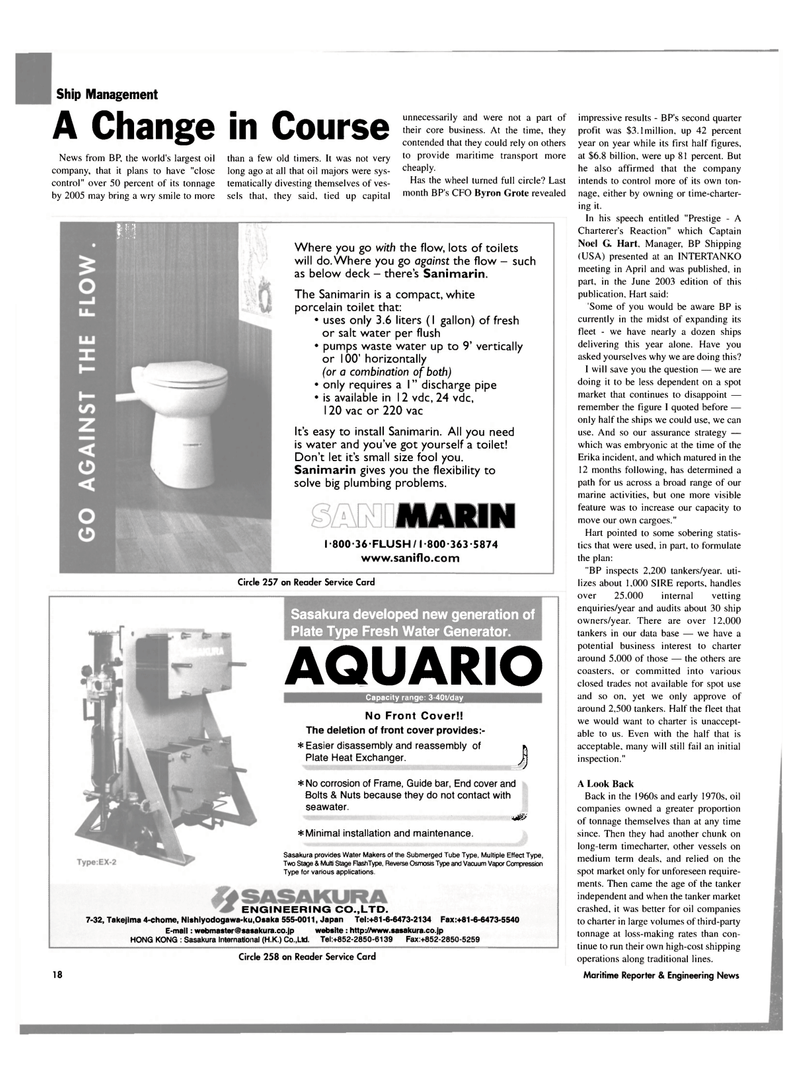
Page 18: of Maritime Reporter Magazine (September 2003)
Read this page in Pdf, Flash or Html5 edition of September 2003 Maritime Reporter Magazine
Ship Management
A Change in Course
News from BP, the world's largest oil company, that it plans to have "close control" over 50 percent of its tonnage by 2005 may bring a wry smile to more
I !• than a few old timers. It was not very long ago at all that oil majors were sys- tematically divesting themselves of ves- sels that, they said, tied up capital unnecessarily and were not a part of their core business. At the time, they contended that they could rely on others to provide maritime transport more cheaply.
Has the wheel turned full circle? Last month BP's CFO Byron Grote revealed
Where you go with the flow, lots of toilets will do. Where you go against the flow - such as below deck - there's Sanimarin.
The Sanimarin is a compact, white porcelain toilet that: • uses only 3.6 liters (I gallon) of fresh or salt water per flush • pumps waste water up to 9' vertically or 100' horizontally (or a combination of both) • only requires a I" discharge pipe • is available in 12 vdc, 24 vdc, 120 vac or 220 vac
It's easy to install Sanimarin. All you need is water and you've got yourself a toilet!
Don't let it's small size fool you.
Sanimarin gives you the flexibility to solve big plumbing problems.
A/IARIN
I-800-36 FLUSH/I-800-363-5874 www.saniflo.com
Circle 257 on Reader Service Card
Sasakura developed new generation of
Plate Type Fresh Water Generator. AQUARIO
Capacity range: 3-40t/day
No Front Cover!!
The deletion of front cover provides:- * Easier disassembly and reassembly of
Plate Heat Exchanger. j *No corrosion of Frame, Guide bar, End cover and
Bolts & Nuts because they do not contact with seawater. •mmmmmmmmmmmmmsmmmmmmmmmmmmmmmmmm^ * Minimal installation and maintenance.
Sasakura provides Water Makers of the Submerged Tube Type, Multiple Effect Type,
Two Stage & Multi Stage RashType, Reverse Osmosis Type and Vacuum Vapor Compression
Type for various applications.
ENGINEERING CO.,LTD. 7-32, Takejima 4-chome, Nishiyodogawa-ku,Osaka 555-0011, Japan Tel:+81-6-6473-2134 Fax:+81-6-6473-5540
E-mail: [email protected] website : http://www.sasakura.co.jp
HONG KONG : Sasakura International (H.K.) Co.,Ltd. Tel:+852-2850-6139 Fax:+852-2850-5259
Circle 258 on Reader Service Card 18 impressive results - BP's second quarter profit was $3.1 million, up 42 percent year on year while its first half figures, at $6.8 billion, were up 81 percent. But he also affirmed that the company intends to control more of its own ton- nage, either by owning or time-charter- ing it.
In his speech entitled "Prestige - A
Charterer's Reaction" which Captain
Noel G. Hart, Manager, BP Shipping (USA) presented at an INTERTANKO meeting in April and was published, in part, in the June 2003 edition of this publication. Hart said: "Some of you would be aware BP is currently in the midst of expanding its fleet - we have nearly a dozen ships delivering this year alone. Have you asked yourselves why we are doing this?
I will save you the question — we are doing it to be less dependent on a spot market that continues to disappoint — remember the figure I quoted before — only half the ships we could use, we can use. And so our assurance strategy — which was embryonic at the time of the
Erika incident, and which matured in the 12 months following, has determined a path for us across a broad range of our marine activities, but one more visible feature was to increase our capacity to move our own cargoes."
Hart pointed to some sobering statis- tics that were used, in part, to formulate the plan: "BP inspects 2,200 tankers/year, uti- lizes about 1,000 SIRE reports, handles over 25.000 internal vetting enquiries/year and audits about 30 ship owners/year. There are over 12,000 tankers in our data base — we have a potential business interest to charter around 5,000 of those — the others are coasters, or committed into various closed trades not available for spot use and so on, yet we only approve of around 2,500 tankers. Half the fleet that we would want to charter is unaccept- able to us. Even with the half that is acceptable, many will still fail an initial inspection."
A Look Back
Back in the 1960s and early 1970s, oil companies owned a greater proportion of tonnage themselves than at any time since. Then they had another chunk on long-term timecharter, other vessels on medium term deals, and relied on the spot market only for unforeseen require- ments. Then came the age of the tanker independent and when the tanker market crashed, it was better for oil companies to charter in large volumes of third-party tonnage at loss-making rates than con- tinue to run their own high-cost shipping operations along traditional lines.
Maritime Reporter & Engineering News

 17
17

 19
19
